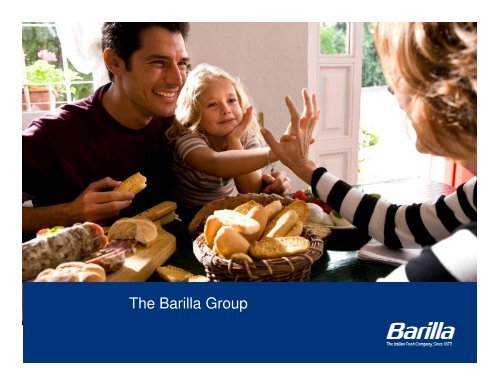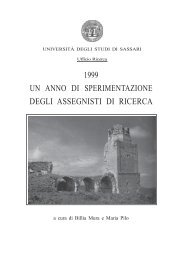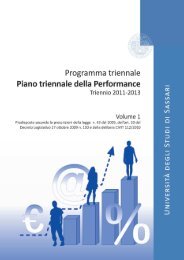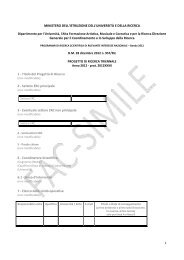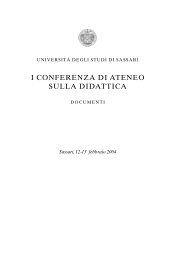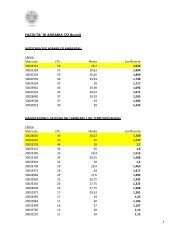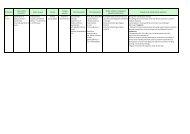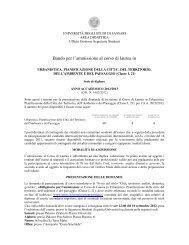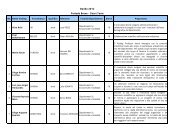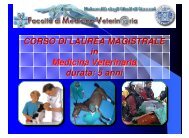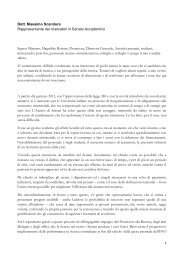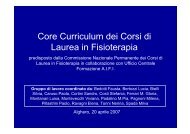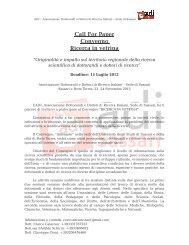The Barilla Group
The Barilla Group
The Barilla Group
Create successful ePaper yourself
Turn your PDF publications into a flip-book with our unique Google optimized e-Paper software.
1<br />
<strong>The</strong> <strong>Barilla</strong> <strong>Group</strong>
2<br />
• <strong>Barilla</strong> was founded in 1877<br />
in Parma, Italy, by Pietro<br />
<strong>Barilla</strong> Senior in a little shop<br />
selling bread and pasta.<br />
<strong>The</strong> <strong>Barilla</strong> <strong>Group</strong><br />
• Today <strong>Barilla</strong> is the largest<br />
Italian food products group,<br />
best selling brand of pasta<br />
in Italy and around the world,<br />
the largest producer of baked<br />
goods in Italy and the third<br />
largest in Europe.
3<br />
Our Vision<br />
“We help people live better,<br />
by bringing wellbeing and the joy of eating<br />
into their everyday lives”.
4<br />
Our Mission<br />
Since 1877 <strong>Barilla</strong> is the Italian Family Company that believes food<br />
is a joyful convivial experience, taste, a form of sharing and caring.<br />
<strong>Barilla</strong> offers quality products that are delightful and safe.<br />
<strong>Barilla</strong> believes in the Italian nutritional model that puts together<br />
superior quality ingredients and simple recipes, creating unique<br />
five-sense experiences.<br />
Sense of belonging, courage and intellectual curiosity inspire<br />
our behaviors and characterize our people.<br />
<strong>Barilla</strong> has always linked its development to people’s wellbeing<br />
and to the communities in which it operates.
5<br />
• Passion<br />
• Intellectual curiosity<br />
• Courage<br />
• Trust<br />
• Integrity<br />
Our Values
6<br />
<strong>Barilla</strong>’s family history<br />
Four generation of entrepreneurs<br />
1877 Pietro 1912 Gualtiero and Riccardo 1947 Gianni and Pietro<br />
1979 Pietro From 1993 Luca, Guido and Paolo
7<br />
•1877<br />
•<strong>The</strong> <strong>Barilla</strong> Family opens in Parma<br />
a shop selling bread and pasta<br />
•<br />
•1910<br />
•First Pasta Factory established<br />
in Parma<br />
Our history<br />
•1965<br />
•First bakery plant opens in the<br />
province of Parma<br />
•1975<br />
•Mulino Bianco created<br />
•1991-1999<br />
•Misko (Greece), Pavesi (Italy), Filiz<br />
(Turkey) e Wasa (Sweden) acquired
8<br />
•1999<br />
•First plant in USA<br />
•2001<br />
•Yemina e Vesta acquired (Mexico)<br />
•2002<br />
Our history<br />
•Lieken (Germany), Harry’s (France,<br />
Spain e Russia) acquired<br />
•2004<br />
•Academia <strong>Barilla</strong> established<br />
•2007<br />
•Second plant in USA<br />
•<br />
•2008<br />
•Merger between <strong>Barilla</strong> and Harry’s<br />
2009<br />
Opening of the European largest<br />
in-house durum wheat Mill in Parma
9<br />
15,000<br />
employees<br />
<strong>The</strong> <strong>Barilla</strong> <strong>Group</strong> in 2009<br />
Annual Report 2009; Internal Data <strong>Barilla</strong><br />
More than<br />
2,500,000<br />
Tons of products<br />
54<br />
Production<br />
sites in 10<br />
countries<br />
20<br />
Leading brands<br />
Export to over<br />
125<br />
Countries<br />
Net sales<br />
4,171<br />
Euro million
<strong>The</strong> <strong>Barilla</strong> <strong>Group</strong> in 2009<br />
• 2,600,000 tons of cereals acquired in 2009<br />
• 70,000 tons of tomatoes (100% Italian)<br />
• 10,000 tons of chocolate (cocoa, cocoa creams and chocolate)<br />
• 20,000 tons of milk and by-products (fresh milk, cheese and<br />
butter)<br />
10<br />
• More than 700 million of eggs per year from 2.5 million hens<br />
• More than 60,000 tons of sugar<br />
• More than 3,000 trucks carry every day our products worldwide<br />
Internal Data <strong>Barilla</strong>
11<br />
Our presence in the world<br />
(2009)
12<br />
<strong>The</strong> <strong>Barilla</strong> <strong>Group</strong><br />
<strong>Barilla</strong> Holding S.p.A.<br />
85%<br />
<strong>Barilla</strong> Iniziative S.r.l.<br />
15%<br />
<strong>Barilla</strong> G. e R. Fratelli S.p.A. Lieken AG<br />
Number 1<br />
logistics group<br />
Gafina B.V.
From breakfast to dinner<br />
•Bakery products<br />
•More than 150 items of biscuits, rusks and morning goods<br />
13<br />
Meal solutions<br />
More than 400 items of pasta and 40 different recipes of<br />
sauces
From breakfast to dinner<br />
Snacks<br />
More than 100 items of minicakes and soft snacks<br />
Smoothies<br />
14<br />
Breads<br />
More than 120 items of soft and dry breads
APPLIED RESEARCH IN DURUM<br />
WHEAT FOR SEMOLINA PASTA
DURUM WHEAT/PASTA PRODUCTION CHAIN<br />
Crop Storage<br />
<strong>Barilla</strong> volumes<br />
Pasta production<br />
1.300.000<br />
ton/year of durum wheat<br />
800.000<br />
ton/year of pasta production<br />
80%<br />
vertical integration<br />
90%<br />
wheat of local origins<br />
Milling
Paolo Cabrini – “Current Hot Topics of the Global Durum Wheat Sourcing Chain”<br />
WORLD - Major Durum Wheat Production Areas<br />
Pasta Trend - Economic International Conference – Bologna, April 24th 2010<br />
17<br />
Source: <strong>Barilla</strong>
Pasta plant<br />
Mill<br />
BARILLA DURUM MILLS AND PASTA PLANTS
INTEGRATED SUPPLY CHAIN
INFORMATION<br />
RESEARCH &<br />
MANAGEMENT<br />
BEST<br />
PRACTICES<br />
BARILLA DURUM WHEAT QUALITY & SAFETY<br />
MANAGEMENT TOOLS<br />
Yield and quality forecast<br />
Food Safety<br />
Management System<br />
Integrated production chain<br />
Market analysis<br />
Exclusive Research, Monitoring and<br />
Purchasing Integrated System<br />
Crop & storage disciplinaries<br />
Harvest mapping<br />
Breeding &<br />
Research<br />
projects<br />
Cultivation Contracts
RESEARCH: DURUM WHEAT BREEDING
Variety Data<br />
BARILLA DURUM WHEATS<br />
Cropping<br />
area<br />
Svevo 1996 South<br />
Baio 1998<br />
Center<br />
North<br />
Quality<br />
performances<br />
Protein +10%<br />
Color +15%<br />
Yield<br />
Zenit 1993 North Color +25% Average/Low<br />
Normanno 2002<br />
Aureo 2009<br />
Tolerance Tolerance to to Fusarium Fusarium<br />
Head Head Blight Blight<br />
Center<br />
South<br />
Center<br />
South<br />
Average/High<br />
consistent<br />
Protein +10% Average/High<br />
Gluten +10%<br />
Protein +10%<br />
Gluten +25%<br />
Protein +15%<br />
Color +10%<br />
Breeding on going<br />
High<br />
Average
FOOD SAFETY
DURUM WHEAT FOOD SAFETY RISKS/TOOLS<br />
Main putative risks<br />
Production chain steps<br />
chemicals<br />
other<br />
seeds<br />
cross<br />
contam.<br />
insects<br />
GMO<br />
micotoxins<br />
heavy<br />
metals<br />
micotoxins<br />
chemical<br />
residues<br />
residue<br />
concentration<br />
by-products<br />
Seed production<br />
Crop<br />
Storage<br />
<strong>Barilla</strong> Mill<br />
Variety<br />
Cross contamination<br />
agronomy<br />
harvest<br />
logistic<br />
pre-cleaning<br />
grain protection<br />
(chemicals, cold, CO2)<br />
logistic (truck, train…)<br />
wheat cleaning<br />
milling<br />
Prevention, management<br />
& control tools<br />
• Fusarium forecast model<br />
• DON mapping of DW harvest;<br />
• Other field contaminant mapping;<br />
• Campaign risk assesment<br />
• Crop Disciplinary;<br />
semolina<br />
• Supplier Audit & omologation<br />
• Storage desciplinary<br />
• HACCP / Contaminant control<br />
plans;<br />
• Lot certification of guarantee<br />
• DW lot control;<br />
Residue<br />
reduction<br />
• DON/other<br />
micotoxins<br />
reduction<br />
studies,<br />
• Support to<br />
associations<br />
for UE limit<br />
definition;
SINSIAF project<br />
Ministero dell’Istruzione,<br />
Università e Ricerca<br />
Progetto n. 12792<br />
Objective<br />
“Development of integrated<br />
system to manage Food Safety<br />
within durum wheat/pasta<br />
supply chain”<br />
• Fungi toxin-producer<br />
• Micotoxins<br />
• Chemicals residues<br />
• Heavy metals<br />
• Prevention<br />
− Knowledge of Fungi ecology<br />
− Simulation model of Fusarium<br />
contaminantion<br />
− Selection of durum wheat lines tolerant to<br />
Fusarium development<br />
• Monitoring<br />
− Fusarium in soils (Italy regions)<br />
− Dynamic maps<br />
− Effect of processing steps on micotoxin<br />
content (DON)<br />
• Rapid methods of analysis<br />
− Multitasking approach<br />
− Technology advancements<br />
• Management<br />
− Data integration in real time<br />
− Advanced tools to support decisions<br />
making<br />
− Quality insurance program
Selection of durum wheat<br />
varieties tolerant to Fusarium<br />
SINSIAF project<br />
Main results<br />
Methods and<br />
equipments for<br />
rapid detection<br />
of contaminants<br />
Development and<br />
deployment of knowledge<br />
Predictive model of Fusarium<br />
micotoxins development
BEST PRACTICES
FS: Traceability System integrated on the entire<br />
durum wheat wheat-semolina semolina chain<br />
(Agri 2000)<br />
A. Evaluation of innovations in organization for for traceability along<br />
durum wheat chain.<br />
◘ Elaboration of an Agronomical Form based both on farmers<br />
needs and agricultural practices requirements<br />
◘ Preparation of a manual with guidelines for the<br />
management of risk and traceability along the production<br />
chain
FS: Protection of durum wheat in<br />
storage conditions<br />
(University of Milan)<br />
◘ Grain screening before storage reduces significantly insects infestation<br />
during storage. <strong>The</strong> effect is stronger on Tribolium spp. spp., , but weaker<br />
on Rhyzopertha dominica and Sitophilus oryzae oryzae. .<br />
◘ Biological pest control �� �� can be applied in storage facilities after<br />
cleaning and before storage, but not directly on grain or semolina.
GOOD AGRONOMY PRACTICES BARILLA:<br />
CULTIVATION AND STORAGE OF HIGH QUALITY<br />
DURUM WHEAT<br />
• First release in 1994 and regularly updated<br />
• <strong>The</strong> Manual includes best practices for appropriate cultivation and storage<br />
of Durum Wheat defined by <strong>Barilla</strong> Company in order to achieve excellent<br />
quality and safety standards required for <strong>Barilla</strong> Pasta.<br />
• <strong>The</strong> Manual is articulated in two main parts:<br />
� Package of agronomy prescriptions to be complied for the cultivation of<br />
durum wheat to be supplied to <strong>Barilla</strong> Company;<br />
� Best practices to be adopted during storage to guarantee correct<br />
preservation of durum wheat to be supplied to <strong>Barilla</strong> Company.
DON geographic<br />
risk assessment<br />
DON PREDICTIVE MODEL: DELPHI<br />
DON risk assessment model<br />
Plant<br />
phenology<br />
model<br />
41.80<br />
41.60<br />
41.40<br />
41.20<br />
15.00 15.20 15.40 15.60 15.80 16.00 16.20<br />
Meteorology<br />
Agronomic Management<br />
Soil<br />
Characterization
DON PREDICTIVE MODEL<br />
• Weather condition, starting from earing, are critical (about 50% relevance) on<br />
fungi development and DON production.<br />
• Agronomy management is the second relevant factor<br />
• Simulations are run twice per week starting from earing both for “climatic<br />
risk” and “global risk” (climatic + agronomy) for 3 main scenarios<br />
• Regions: Emilia Romagna, Toscana, Marche, Puglia, Basilicata + Mantova<br />
and Rovigo districts<br />
<strong>The</strong> output:<br />
Climatic risk assessment<br />
DON occurrence for<br />
agronomy scenario<br />
Risk to exceed the limit<br />
for agronomy scenario
APPLIED RESEARCH IN BARILLA DURUM WHEAT<br />
MANAGEMENT<br />
• PREVENT<br />
– Breeding<br />
– Good Agronomy Practices<br />
– Good Storage Practices<br />
• PREDICT<br />
– Predictive models<br />
– In field controls<br />
• CONTROL<br />
– Sampling network<br />
– Rapid Methods
THANK YOU FOR THE KIND ATTENTION<br />
www.barillagroup.com


